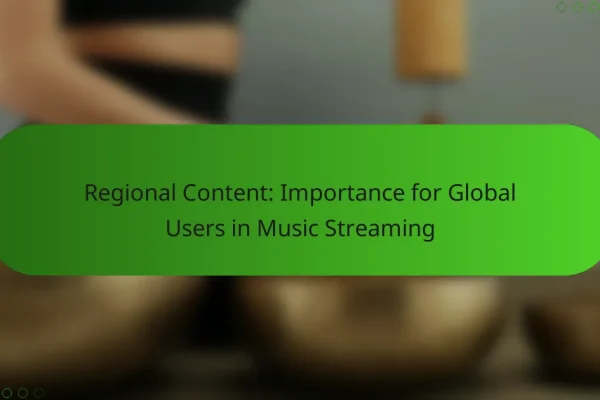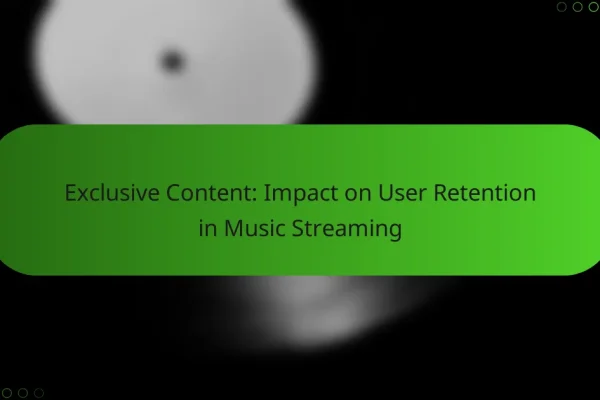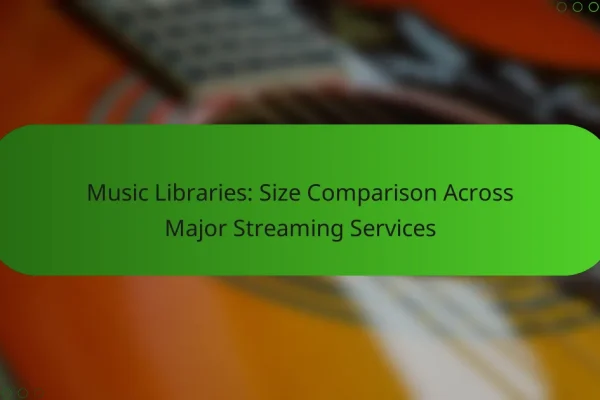How does content variety impact music streaming in the US?
Content variety significantly enhances the music streaming experience in the US by attracting a broader audience and keeping users engaged. A diverse library allows listeners to explore different genres and artists, which can lead to increased satisfaction and loyalty.
Enhances user engagement
A rich selection of music encourages users to spend more time on streaming platforms. When listeners can discover new tracks and revisit old favorites, they are more likely to interact with the app frequently. Features like personalized playlists and recommendations thrive on a diverse content library, making the user experience more dynamic.
For example, platforms that offer a mix of mainstream hits and niche genres can cater to varied tastes, keeping users engaged and reducing the likelihood of churn. This engagement is crucial for platforms aiming to build a loyal user base.
Diverse genre representation
Diverse genre representation in music libraries allows streaming services to appeal to a wider demographic. By including genres ranging from pop to indie, hip-hop to classical, platforms can attract listeners with different musical preferences. This inclusivity not only enhances user satisfaction but also fosters a sense of community among fans of various styles.
Moreover, genre diversity can lead to cross-pollination, where listeners discover new music outside their usual preferences. This can be particularly beneficial for emerging artists looking to reach new audiences.
Increases subscription retention
Having a varied music library is essential for increasing subscription retention rates. Users are less likely to cancel their subscriptions if they feel they have access to a comprehensive selection of music that meets their evolving tastes. Regular updates and the addition of new genres can keep the content fresh and engaging.
Streaming services that prioritize content variety often see higher customer loyalty. For instance, platforms that regularly introduce curated playlists or exclusive releases can entice users to maintain their subscriptions, knowing they will always have something new to explore.
What are the key features of popular music streaming libraries?
Popular music streaming libraries offer a variety of features that enhance user experience, including personalized playlists, exclusive releases, and extensive catalogs. These features cater to diverse musical tastes and preferences, making it easier for users to discover and enjoy new music.
Spotify’s personalized playlists
Spotify is well-known for its personalized playlists, such as Discover Weekly and Daily Mix, which curate songs based on users’ listening habits. These playlists are updated regularly, allowing listeners to explore new tracks that align with their musical preferences.
To maximize the benefits of Spotify’s personalized playlists, users should engage with the platform by liking songs and following artists. This interaction helps the algorithm refine recommendations, leading to a more tailored listening experience.
Apple Music’s exclusive releases
Apple Music frequently offers exclusive releases, including albums and singles from popular artists that are not available on other platforms. This feature attracts users who want access to the latest music as soon as it drops, often before it is released elsewhere.
To take advantage of these exclusive releases, users can keep an eye on Apple Music’s curated playlists and notifications. Subscribing to artist alerts can also ensure that fans are informed about new content as soon as it becomes available.
Amazon Music’s extensive catalog
Amazon Music boasts an extensive catalog that includes millions of songs across various genres, catering to a wide range of musical tastes. This vast selection allows users to explore both mainstream hits and lesser-known tracks, enhancing their overall listening experience.
Users can benefit from Amazon Music’s catalog by utilizing its search and filter features to discover new music. Additionally, Prime members often enjoy access to a larger selection of songs without additional costs, making it a cost-effective choice for avid listeners.
How do music streaming services curate their libraries?
Music streaming services curate their libraries through a combination of technology and user engagement. They utilize algorithms, user-generated content, and partnerships with record labels to ensure a diverse and appealing selection of music for their subscribers.
Algorithm-driven recommendations
Algorithm-driven recommendations are a key feature of music streaming services, using data analytics to suggest songs based on user preferences and listening habits. These algorithms analyze factors such as previously played tracks, user ratings, and even the time of day to create personalized playlists.
For example, services like Spotify and Apple Music often provide curated playlists like “Discover Weekly” or “For You,” which introduce users to new artists and genres. This approach helps maintain user engagement by continually refreshing the listening experience.
User-generated playlists
User-generated playlists allow subscribers to create and share their own collections of songs, fostering community and personal expression. These playlists can range from thematic collections, like “Chill Vibes” or “Workout Jams,” to more niche compilations that reflect individual tastes.
Streaming platforms often highlight popular user-generated playlists, which can influence trends and help lesser-known artists gain exposure. Users can also follow others to discover new music, enhancing the social aspect of music streaming.
Partnerships with record labels
Partnerships with record labels play a crucial role in shaping the music libraries of streaming services. These collaborations allow platforms to offer exclusive content, such as early releases or unique live recordings, which can attract subscribers.
Additionally, record labels often provide promotional support for new artists, ensuring that their music reaches a wider audience. This symbiotic relationship benefits both the streaming service and the labels by driving user engagement and increasing revenue through subscriptions.
What criteria should users consider when choosing a music streaming service?
When selecting a music streaming service, users should evaluate factors such as library size, audio quality, and pricing models. These criteria significantly influence the overall listening experience and satisfaction with the service.
Library size and variety
The library size and variety of a music streaming service determine how many songs, albums, and genres are available to users. A larger library often includes a wider range of artists and styles, catering to diverse musical tastes.
Consider services that offer millions of tracks, as this typically ensures access to both popular hits and niche genres. Additionally, check for exclusive content, such as live recordings or artist interviews, which can enhance the overall experience.
Audio quality options
Audio quality is crucial for an enjoyable listening experience, especially for audiophiles. Streaming services often provide different quality settings, ranging from standard to high-resolution audio.
Look for options that allow streaming at higher bit rates, such as 320 kbps for MP3 or lossless formats like FLAC. Some services may even offer spatial audio features, enhancing the listening experience with immersive sound.
Pricing and subscription models
Pricing and subscription models vary widely among music streaming services, affecting accessibility and user choice. Most platforms offer free tiers with ads, as well as premium subscriptions that provide ad-free listening and additional features.
Evaluate the monthly cost of subscriptions, which can range from around $5 to $15 USD, depending on the service and features included. Some platforms also offer family plans or student discounts, providing more affordable options for different user needs.
How do regional differences affect music streaming content?
Regional differences significantly impact the content available on music streaming platforms due to variations in licensing agreements, local artist representation, and genre popularity. These factors can lead to a diverse listening experience depending on the user’s location.
Licensing agreements vary by country
Licensing agreements dictate which music can be streamed in specific regions. These agreements are often influenced by local copyright laws and negotiations between streaming services and record labels. As a result, some platforms may have extensive libraries in one country while offering limited selections in another.
For example, a popular streaming service might have exclusive rights to certain albums in the United States but not in Europe. This discrepancy can lead to frustration for users seeking specific tracks or artists that are unavailable in their region.
Local artist representation
Local artist representation plays a crucial role in shaping the music streaming landscape. Streaming platforms often prioritize artists from the region to cater to local tastes and preferences. This means that users in different countries may discover a wealth of homegrown talent that reflects their cultural context.
For instance, a user in Brazil may find a rich selection of samba and bossa nova artists, while a listener in Japan might have access to a variety of J-Pop and traditional Japanese music. This localized focus enhances the overall listening experience and fosters a connection to regional music scenes.
Regional genre popularity
Regional genre popularity influences the types of music that are prominently featured on streaming services. Different areas have distinct musical tastes, which can affect playlist curation and promotional efforts by platforms. For example, hip-hop may dominate in urban areas of the United States, while folk music might be more popular in rural regions of Europe.
Streaming services often analyze user data to tailor their offerings, ensuring that popular genres in a specific region are easily accessible. This approach not only supports local artists but also helps users discover new music that resonates with their cultural background.
What are the emerging trends in music streaming libraries?
Emerging trends in music streaming libraries include the rise of personalized playlists, the integration of social features, and the expansion of exclusive content. These trends reflect the evolving preferences of listeners and the competitive landscape of music services.
Personalized Playlists
Personalized playlists are increasingly popular as streaming services leverage algorithms to curate music tailored to individual tastes. These playlists often adapt based on user behavior, making recommendations that align with listening habits. Services like Spotify and Apple Music frequently update these playlists, ensuring fresh content that resonates with users.
To maximize the benefits of personalized playlists, users should engage with the platform by liking songs and exploring new genres. This interaction helps refine the algorithm, leading to more accurate recommendations over time.
Integration of Social Features
Social features in music streaming libraries allow users to share playlists, follow friends, and discover music together. This trend enhances user engagement and fosters a sense of community among listeners. Platforms like Tidal and SoundCloud are leading the way by incorporating social sharing options and collaborative playlists.
To take advantage of these social features, users can connect their accounts with social media platforms, enabling easy sharing and discovery of new music through friends’ recommendations. However, privacy settings should be reviewed to control what is shared publicly.
Expansion of Exclusive Content
Exclusive content, such as artist interviews, live performances, and original podcasts, is becoming a key differentiator among streaming services. Platforms are investing in unique offerings to attract subscribers and retain existing users. For example, Apple Music has secured exclusive album releases and original documentaries featuring popular artists.
Consumers should consider the value of exclusive content when choosing a streaming service. While some platforms may offer a wider library, others might provide unique experiences that enhance the overall listening journey. It’s worth exploring trial subscriptions to assess which service aligns best with personal preferences.










